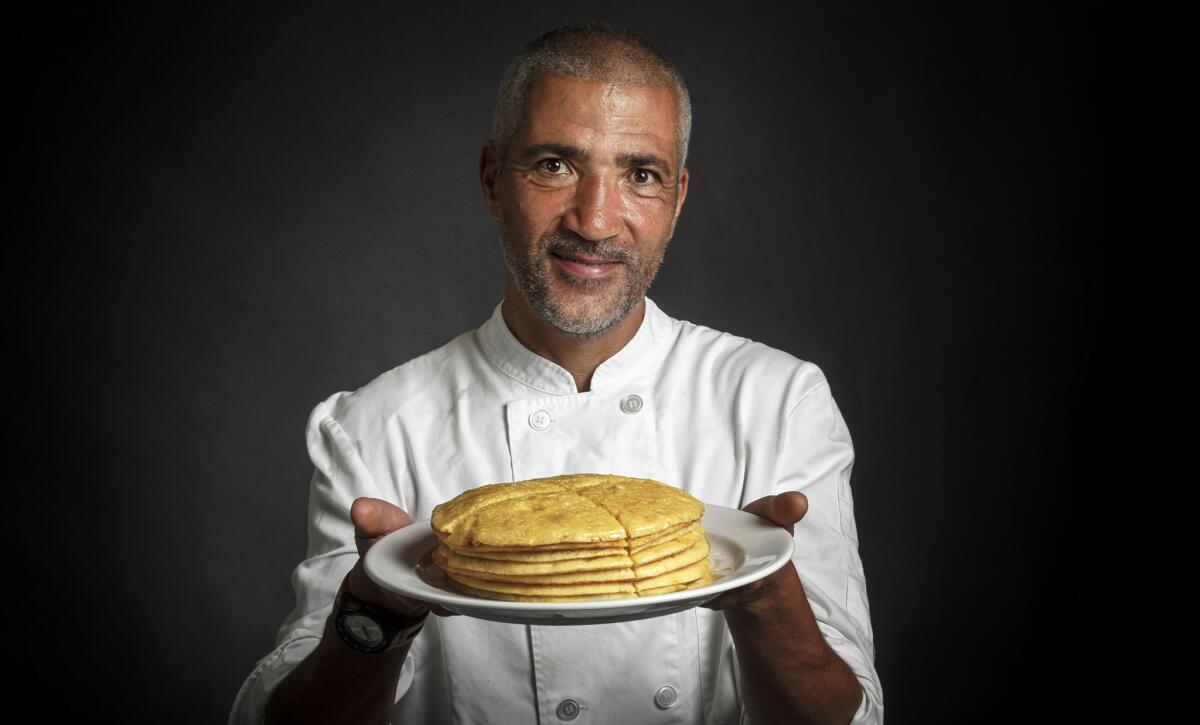A buttery cake for Ramadan reminds a chef of his childhood

Chef Farid Zadi holds up some delicious “Baghrir.”
- Share via
“That smell, it reminds me of when I was a baby,” Farid Zadi says softly as he gently brushes melted butter over the thin cake. He’s making a traditional sweet called baghrir — it’s a sort of cross between pancakes and crepes — that he stacks on a plate. Baghrir is an ancient Berber dish native to North African countries including Morocco, Tunisia and Algeria.
After the butter, he’ll brush over a sweet but tangy orange-maple syrup reduction. The syrup isn’t traditional. “It’s North African-Canadian,” Zadi jokes. “I like to be different.”
Zadi, 47, demonstrates baghrir for Ramadan in the Los Angeles Times Test Kitchen. But the smell of melted butter over the warm cake takes him back to his mother’s kitchen, when she would stack and brush the cakes with the more traditional sweetened honey-butter syrup for Zadi and his five siblings. While baghrir is eaten year-round, it’s popular at Ramadan to help break the daily fast at the evening meal, known as iftar. “You need that sugar after fasting all day,” he says, smiling.
Get the recipe for baghrir here
For Zadi, born in Lyon, France, his culinary traditions are heavily influenced by his parents, who emigrated from Algeria. He has been cooking professionally for almost 35 years and was a longtime instructor at Le Cordon Bleu in Pasadena. His new project is Revolutionario, a North African taqueria in Exposition Park.
Zadi is standing over a large bowl as he adds equal parts all-purpose and semolina flours, along with a little salt and sugar. He stirs in yeast, then a touch of oil. While the mixture can be made more simply using a blender, he prefers to do it by hand. “Did my mom have a blender? I don’t think so,” says the chef. “It’s important to touch and feel everything.”
He adds water, a little at a time, massaging the mixture with his fingers to work out any lumps. Finally, he adds an egg and some baking powder, using a hand whisk to smooth out the batter. Then he covers it in plastic wrap and sets it aside, waiting for it to begin to bubble and puff up, about 30 minutes. In the meantime, Zadi begins to simmer a saucepan of orange juice, maple syrup and sugar, watching until the mixture thickens to a thin syrup. “Not too thick; you need to brush it over the baghrir.”
In the Kitchen: Sign up for our weekly cooking newsletter
Soon enough, the batter is ready. Where it was once thin and loose, it’s now thickened and bubbly. “See how nice and smooth? It’s light and beautiful,” Zadi says.
He heats a cast-iron skillet with a little oil, then ladles over the batter. Immediately, it begins to sizzle, the batter puffing and bubbling. “We call this dish A Thousand Holes. See why?” Zadi asks. As it cooks, holes continue to appear, the cake slowly setting on the edges.
Baghrir cooks only on one side, and Zadi moves the pan so the batter cooks evenly, the cake setting completely on top. He touches the top of the cake; if it’s done, it won’t stick to his fingers. Ready, he moves the cake to the plate to be brushed.
He ladles more batter into the pan, letting it cook as he brushes the finished cake, first with butter, then the syrup. The sweet aroma fills the kitchen. When the batter is gone, he has a stack of several cakes.
Zadi cuts the stack into quarters. Asked how it’s eaten, he says simply, “Me? I probably eat two [quarters].” But it’s important to have more for others, as breaking the fast is often a social meal. “Be generous. Give to people who don’t have enough resources to have a decent iftar. Ramadan is all about giving.”
Twitter: @noellecarter
More to Read
Eat your way across L.A.
Get our weekly Tasting Notes newsletter for reviews, news and more.
You may occasionally receive promotional content from the Los Angeles Times.











